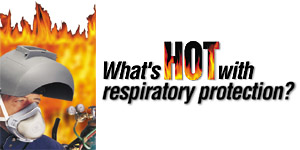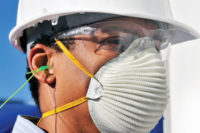
Your respiratory program is in place, your equipment works well and employees are using it. Now come the pressures to change - changes driven by: OSHA regulations, new and improved technology, modifications in your work environment, tighter budgets and greater employee awareness of new threats to respiratory health, just to name a few.
How should you go about making the changes? Should you make any at all? What should they be? How do you weigh the benefits versus the costs of these changes?
The following ten points should be considered when determining whether changes are in order for your respiratory program and/or equipment selection.
1) Compliance
As with the 1998 OSHA changes in regulations on respiratory protection, specified in 29 CFR 1910.134, there may be no choice but to take certain actions to remain in compliance. Changes in regulations are made to protect the health and safety of workers. Therefore, your company should thoroughly study the regulations and evaluate various ways of meeting them within a prescribed timetable.2) Comfort/acceptance
Respirator use has gradually gained acceptance over the years as employer-sponsored informational and motivational programs have educated workers about the importance of avoiding respiratory hazards. Nevertheless, user comfort and acceptance obstacles remain - obstacles that often can be reduced or eliminated with material or design improvements.Facepieces made of silicone, for example, cost more than commonly used thermoplastic or rubber facemasks. However, if the greater softness, better-fitting characteristics and durability of silicone improve employee comfort and productivity while reducing company liabilities for employee noncompliance, silicone respirators may represent the better value and a reason to change equipment.
Have several users try the new equipment and rate subjective aspects, such as comfort, weight, ease of use and overall equipment preference. If workers are involved in the selection process they are more likely to accept changes in the equipment they use.
3) Protection
When considering a change of equipment or safety program procedures, worker protection is the key criteria. Will the change offer the correct level of protection? It is essential to test the effectiveness of new equipment in your particular work environment, and to make sure that workers are properly trained and understand and accept its use.4) Work environment
Safety professionals should routinely re-evaluate the work environment when major new processes and materials are introduced. It also pays to monitor and reassess the work environment periodically to ensure that changes, such as substitute solvents, cleaners, coatings and other hazards, are addressed with your current respiratory equipment.
Likewise, it is a good safety practice to reassess the work environment whenever different equipment or procedures are considered. This will ensure that a proposed innovation will protect against all hazards that exist within the current environment.
5) Training
How will new technology and/or procedural changes affect user training? Will they simplify or add to the user training requirements? What programs or aids are available to assist with the training? What are the costs, in terms of employee time and training materials required? The trend is to simplify user training. The easier safety equipment is to use, the more likely it will be used and used properly.6) Administration
Advances in technology can improve and simplify the way a safety program is administered. For example, estimating service life of gas and vapor cartridges and preparing cartridge change schedules can pose an administrative burden on some companies. To eliminate the need for cumbersome change schedules and simplify user training, end-of-service-life indicators (ESLIs) have been developed that are placed inside the gas and vapor cartridges to give workers real-time indication of cartridge service life. Gas and vapor cartridges with this ESLI technology are currently available for protection against ammonia as well as hydrogen chloride, hydrogen sulfide, sulfur dioxide and hydrogen fluoride. Gas and vapor cartridges with other ESLIs are being developed.
Safety pros should continually evaluate technology innovations to realize efficiencies in safety program administration as well as gains in worker protection - and perhaps even competitive gains for their company.
7) Liability
Asbestos, lead and mining-related bankruptcies are examples of the liability extremes to which respiratory illnesses can lead. Similarly, other contaminants such as toxic molds, which have received a lot of press lately, if not dealt with properly may become the asbestos cases of tomorrow.
To avoid these and many less extreme, but costly, liabilities, safety pros must sometimes convince management of the necessity of higher levels of protection than currently mandated by government agencies. The benefits of avoiding future liabilities can be estimated in terms of potential reductions in the costs of disability and medical claims as well as lost time. Consider also that proper respiratory protection can help keep medical and workers' compensation insurance rates lower than they otherwise might be.
8) Value
Carefully weigh a lower price versus the life-cycle costs of a respirator. You usually get what you pay for. However, remember to evaluate first cost versus life-cycle costs within the context of your particular application.
For example, do you require dust masks for intermittent use during a very short-term project? If so, inexpensive disposable dust masks could be the best buy. However, if your employees routinely work in dusty environments for hours at a time, the amount and cost of dust masks used can add up quickly and can cost thousands of dollars annually per worker. If this is the case, consider an alternative to disposable dust masks, such as North's new reusable half-mask with disposable particulate filters. In addition to venting hot exhaled air for cooler and easier breathing, the half-mask protects the disposable filters from sweat and moisture, extending the filter's useful life and reducing filter consumption, which translates into good economics.
9) Costs & savings
While a written respiratory protection program and assiduous implementation of a safety program have certain costs attached to them, safety pays. There's been a lot said lately on how to calculate the business costs and cost savings of safety programs. On the debit side of the ledger are the expenses for a safety professional, equipment and training. On the credit side, savings may include fewer or no lost workdays, better employee health, increased productivity, lower insurance costs and significant reductions in potential liabilities. (Refer to "Can you prove safety & health's bottom line benefits? Is it necessary?,"ISHN, April 2002, for ideas on estimating the cost savings provided by safety programs.)10) Culture
Less easily calculated are the savings that come as a result of an improved company culture. Still, many business management studies ("Theory Z: How American Business Can Meet the Japanese Challenge" by William G. Ouchi, for example) have researched company cultures and extolled the successes of those that foster the well-being of employees.
Managers who place a high priority on worker safety contribute to a company culture in which employees are motivated to work more productively and, ultimately, to the company's success.
SIDEBAR: When change is in the air?/i>
Questions to ask when weighing the pros and cons of respiratory program changes should include:
- How well do the proposed changes respond to workers' requirements for increased comfort and performance?
- Do the new technologies satisfy company objectives to reduce liabilities and improve employee protection by increasing user acceptance?
- Do the new products meet other specific objectives, such as reduced costs and decreased inventory expense?
- Will the changes help to simplify user training, decrease administrative work, increase productivity and improve the company culture?
